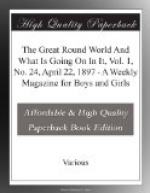DEAR MR. EDITOR:
I wish to tell Grace of some good books. Three of C.M. Yonge’s books, “Dynevor Terrace,” “The Daisy Chain,” and its sequel, “The Trial,” are stories of English boys and girls, much like “Little Women.” Elizabeth Stuart Phelps’ “Gypsy Breynton” series are good. The last of the series “Gypsy’s Year at the Golden Crescent” is a boarding-school story. “The Five Little Peppers” series by Margaret Sidney are her best books. The five little Pepper boys and girls live in “the little brown house” with “Mamsy.” Their father is dead, and they are very poor. They gain a rich friend, a very nice boy named Jasper, and all go to live in his father’s house, “Mamsy” becoming the housekeeper. It is all written in a delightful and natural manner.
Flora Shaw’s three books, “Hector,” “Phyllis Browne,” and “Castle Blair,” are also good. In the first, Hector, a little English boy, goes to France to live with his little country cousin Zelie. In the second a little Pole, Count Ladislas Starinski, comes to England to live with his English cousins. The last is the story of five Irish boys and girls, their big dog Royal, and their two cousins Frankie and a French girl Adrienne (whose name they could not pronounce, and so they called her Nessa, after one of their dogs which had died, and which they said looked like her).
Elizabeth Champney’s
“Witch Winnie” series are very interesting.
The first two, “Witch
Winnie” and “Witch Winnie’s Mystery,”
are
boarding-school stories.
Other good books are: “When I Was Your Age,” by Laura Richards; “Two Girls,” and “Girls Together,” by Miss Blanchard; “Half a Dozen Girls,” by Anna Chapin Ray; “Dr. Gilbert’s Daughters,” by Margaret Matthews; “Captain Polly,” “Flying Hill Farm,” and “The Mate of The Mary Ann,” by Sophie Sweet; “Summer in a Canon,” and “Polly Oliver’s Problem,” by Kate D. Wiggin; The “Katy Did” series, by Susan Coolidge; the Quinnebasset Series, by Sophie May, comprising “The Doctor’s Daughter,” “Asbury Twins,” “Our Helen,” “Janet,” and “Quinnebasset Girls”; “The Jolly Good Time” books, by Mary P. Wells Smith; and all the books of Lucy C. Lillie, Nora Perry, Mrs. Mead, and Mrs. Molesworth.
I have read and enjoyed all the
above, and can recommend them to
any one as delightful stories of boys and girls.
EDITH.
MY DEAR EDITH:
We are glad to have your nice letter to publish, and will be pleased to have you read for us.
EDITOR.
DEAR MR. EDITOR:
Miss Bessy reads THE GREAT ROUND
WORLD, and will you
please send me a pattern of the kite of Lieutenant
Wise?
Yours
truly,
SYDNEY
G.
BALTIMORE, MD., March 26th, 1897.
MY DEAR SYDNEY G.:
“The American Boy’s Book of Sport,” published by Charles Scribner’s Sons, and mentioned in No. 21 of THE GREAT ROUND WORLD, will tell you how to make kites of all kinds. We cannot promise that you will find Lieutenant Wise’s kite there, because we think he has kept the manner of making his kite a secret, and will do so until he has quite finished his experiments with it.




